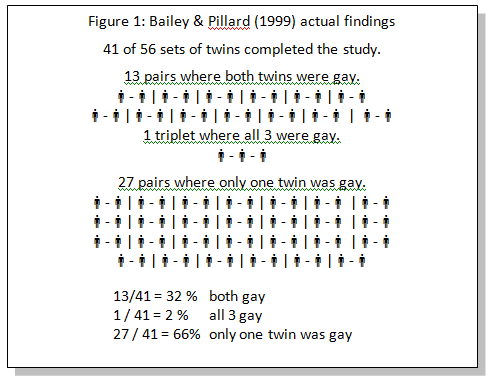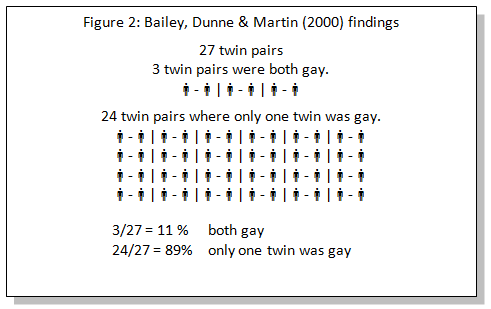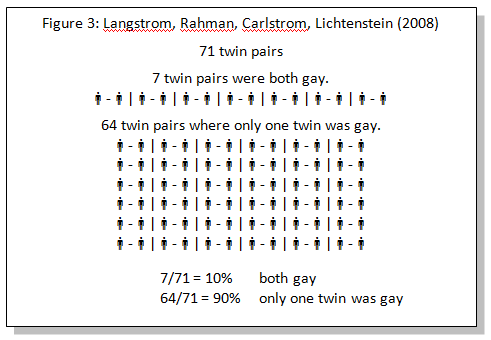Twin Studies: What They Don’t Show
We use Scripture, experience and knowledge to guide us in faith and life. Some of our knowledge comes from science. Sadly, misunderstandings and misrepresentations of scientific research have been used to encourage people to ignore Scripture, abandon faith and embrace homosexuality as if they have no choice.
Misunderstandings and misrepresentation of twin studies has led many people to believe twin studies have conclusively shown that there is a genetic basis for sexual orientation. The claim that twin studies have proven people are born gay is a misrepresentation of the studies’ finding and too simplistic for the complexities of sexual attractions. Don’t let such misrepresentations lead you away from Scripture or faith. People who experience same-sex attractions can still make choices.
Twin studies continue to find steadily lower genetic input into homosexuality as methodology improves and samples become larger. Combining the results from six studies between 2000-2011, researchers found that if one identical twin has same-sex attractions, the chances that their co-twin also has same-sex attractions, are only about 11% for men and 14% for women. And contrary to what many people mistakenly believe, twin studies show that identical twin brothers, growing up with the same genes, same parents, in the same time and place, at the same point in history, can experience different outcomes.

The probandwise concordance of 52%, reported in the 1999 Bailey study, is often misunderstand. It does not mean that 52% of identical twins have same-sex attractions. Nor does it mean that the only thing affecting them are genetic factors. Nor does it mean that homosexuality is genetically inevitable for 52% of the people who experience same-sex attractions.
Jones & Yarhouse (2000) calculated the pairwise concordance from the original data in Bailey’s paper. They found that if one identical twin has SSA, the chances of the second twin having SSA are 11%. Such a low statistic contradicts the claims that this study found a genetic basis for homosexuality.
The Bailey 1999 study also included fraternal twins and adopted brothers. The study reported a statistically significant higher homosexual correlation among fraternal twins than among other brothers. Which raised another question – since fraternal twins don't share a common genetic make-up, what makes this correlation so much higher?
The study also reported an 11% correlation between adopted brothers. Adopted brothers don’t share any genetics and yet there was a higher homosexual correlation in these families than the general population. Why was that happening? Something was causing homosexuality to occur more frequently in the families that were studied, but there can’t be a genetic reason for the increase.
Questions from other scientists about the study methods, mathematics and the findings from the data led Bailey to admit there were problems in the study. There was a crucial methodological problem; the method of obtaining people by ads in openly pro-gay magazines created a volunteer sample bias. This bias meant the 1999 study was not valid.
The decisive refutation of the 1999 study was provide by Bailey himself in his next study. Bailey, Dunne & Martin published another study in 2000. This study used a sample drawn from the Australian twin registry. In this study the probandwise concordance dropped from 52% to 20% for identical twins. Quoting from Bailey, et al, 2000: The new study "did not provide statistically significant support for the importance of genetic factors" in causing homosexual orientation. "This suggests that concordances from prior studies {i.e. his own two prior studies) were inflated due to concordance dependent ascertainment bias."
Subsequent studies continued using twin registry data with larger and less biased samples. And they provided clearer explanations of the mathematics.
Figures 2 and 3 present the findings from Bailey's 2000 study and Långström's 2008 study.
Subsequent twin studies and their countries of origin include Hershberger (1997), United States; Bailey, Dunne, and Martin (2000), Australia; Kendler, Thornton, Gilman, and Kessler (2000), United States; Bearman and Brueckner (2002), United States; Santtila, Sandnabba, Harlaar, Varjonen, Alanko, and von der Pahlen (2008), Finland; Långström, Rahman, Carlström, and Lichtenstein (2010), Sweden; and Alanko, Santtila, Harlaar, Witting, Varjonen, Jern, Johansson, von der Pahlen, and Sandnabba (2010), Finland.
Combining the results from six studies between 2000-2011, researchers found that if one identical twin has same-sex attractions, the chances that their co-twin also has same-sex attractions, are only about 11% for men and 14% for women. As said above, twin studies continue to find steadily lower genetic input into homosexuality as methodology improves and samples become larger. And contrary to what many people mistakenly believe, twin studies show that identical twin brothers, growing up with the same genes, same parents, in the same time and place, at the same point in history, make separate choices most of the time.
We are so influenced by the teaching that we are a product of our genes and our past experiences that we often have difficulty thinking that we can make choices. We can even struggle with faith in God when experiencing same-sex attractions. Our faulty thinking says, "My genes made me a certain way, I have no choice”. The Bible says differently, saying that we are truly free to choose God's way or our way. This is an awesome thing. It is one facet of being made "in the image of God".
The Bible and science both tell us that we can make choices. Twin studies show that identical twin brothers, growing up with the same genes, the same pre-natal experiences, the same parents, in the same home environment can experience different outcomes. And the decisions we make have an impact on such outcomes. We need to stress here that no one chooses to experience same-sex attractions. One twin doesn't choose to experience same-sex attractions and the other not, but our decisions have consequences that go far beyond what we can anticipate. We can choose how we will respond to our life situation. For those of us who believe that genes do not pre-program us, we see an element of choice in who we become.
This is indeed good news, because we can make new choices, and we can have new experiences of growth and healing that offer the possibility of very significant change for people experiencing same-sex attractions or involved in homosexuality. Scriptures describe Christian life as being born again, becoming a new creation and changing from being dead to alive. God invites people, including those with same-sex attractions, to have an intimate relationship with Christ and develop a capacity for living with integrity in Christ. Don’t let misrepresentations about twin studies persuade you that God’s invitation doesn’t apply to you or that your experience of same-sex attractions prevents you from experiencing it.
References
Bailey, M, Pillard, R (1991) A Genetic Study of Male Sexual Orientation, Archives of General Psychiatry, 1991, no 48, 1089-1096.
Bailey, J.M., Dunne, M.P., & Martin, N.G. (2000). Genetic and Environmental influences on sexual orientation and its correlates in an Australian twin sample. Journal of Personality and Social Psychology, 78, 524-536.
Bearman, P.S., & Bruckner, H. (2002). Opposite-sex twins and adolescent same-sex attraction. American Journal of Sociology, 107, 1179-1205.
Buhrich, N., Bailey, J.M., & Martin, N.G. (1991). Sexual orientation, sexual identity, and sex-dimorphic behaviors in male twins. Behavior Genetics, 21, 75-96.
Hershberger, S.L. (1997). A twin registry study of male and female sexual orientation. Journal of Sex Research, 34, 212-222.
Jones, SL and Yarhouse , MA (2000) Homosexuality. The Use of Scientific Research in the Church’s Moral Debate. IVP, 2000.
Kendler, K. S., Thornton, L. M., Gilman, S. E., & Kessler, R. C. (2000). Sexual orientation in a U.S. national sample of twin and nontwin sibling pairs. American Journal of Psychiatry, 157, 1843–1846.
Långström N, Rahman Q, Carlström E, Lichtenstein P. 2010. Genetic and Environmental Effects on Same-sex Sexual Behavior: A Population Study of Twins in Sweden. Archives of Sexual Behavior 39(1):75-80.
Medinger, A, Twin Studies: What Do They Show?, Regeneration Ministries, 1992.
Santtila, P., Sandnabba, N.K., Harlaar, N., Varjonen, M., Alanko, K., & von der Pahlen, B. (2008). Potential for homosexual response is prevalent and genetic. Biological Psychology, 77(1), 102-105.
Whitehead, N, Whitehead, B, My Genes Made Me Do It, Whitehead Associates, 2014.





